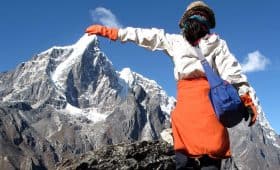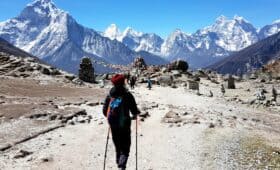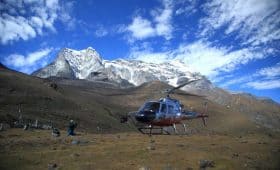Looking around for Ultimate Packing List for Everest Base Camp Trek? Our expert team member here at Mosaic Adventure has meticulously prepared this detailed guide based on his decade long experience. Remember a simple rule: Pack lightly, Pack wisely.
Everest Base Camp -EBC is a dream destination for many adventurers, and like you, many avid travelers plan to visit the base camp of the world’s tallest peak, Mount Everest.
While planning your visit, it is crucial to consider the Everest Base Camp Packing List. Knowing what to pack for the trip is essential to avoid any mishaps during the journey.
Missing out on essential items can make your trip flawed, but having everything you need on your back can save you from a lot of trouble.
One of the most challenging tasks is packing for the Everest Base Camp Trek. Fortunately, you don’t have to look any further for the Everest Base Camp packing list.
This blog is a comprehensive guide compiled with input from expert trekkers and Sherpa guides who have visited the place many times.
The advice is based on authentic EBC experiences, ensuring that you are well-prepared for the trek.
The journey to Everest Base Camp is one of the best walks in the world, and it’s an amazing experience to reach the destination. However, packing right is crucial to ensure that you make the most out of the trip.
You’ll need sturdy and comfortable shoes, a warm down jacket, sunscreen, and more. Let’s dive into the details.
Trekking to Everest Base Camp requires a significant amount of preparation, including physical, emotional, and mental readiness for the two-week trek. You’ll also need to gather all the necessary items and gear to ensure a smooth and safe journey.
Table of Contents
Ultimate Packing list for Everest Base Camp Trek
Are you wondering what to pack on your Everest Base Camp trek? Well, there are a few guidelines that will help you decide what essential items you can’t skip and what things you might forego bringing. When packing, consider EBC packing list to make your trip more entertaining and comfortable:
Dress in layers (Clothing)
The clothing you should pack depends on the season you plan your Everest Base Camp tour. It also depends on the trek that you plan to do.
The first few days of the trek can be warm enough to wear shorts and light shirts, but mornings and nights are colder. Dress in two to three layers so that your body can easily regulate the temperature and adjust as needed.
Choose clothes that you can easily zip on and off as the temperature changes. Layering is the key concept during trek plans because of the difference in temperature, altitude, and many other factors. You will stay comfortable, safe, and secure when you can add and remove layers of clothing during your trek.
Inner Layer (Base Layer)
The inner layer is the clothing that you wear next to your skin. It provides warmth to your body in the high and cold areas of the trek. The base layer is essential for greater altitude and cold weather.
If your chosen trek has colder parts, the base layer will help you stay warm, and you will be able to enjoy your trek to its fullest.
This means that you will wear this layer only after reaching the higher parts but not the first or last parts of the trek. While trekking in the lower regions, your body doesn’t need that much warmth.
So, pack an excellent inner layer for the cold days of the trek. While choosing an inner layer set, look for comfort, fit, and material. It should fit your skin comfortably without causing any itchiness. The next thing you should look out for is the material.
The base layers are made of materials such as synthetic fibers or wool. These materials are good at absorbing moisture.
Hence, choose an inner layer set that can keep your skin dry and warm. We highly recommend a base layer of merino wool as it can absorb moisture from your body, and you can have it at an affordable price.
Insulation Layers
The insulation layer is the second layer worn outside the base layer. Generally, you can use fleece clothing for this layer. The layer helps to keep body heat and protect your body from the cold.
The thicker the insulation layers, the more warmth you will get. However, do not look for thick fleece jackets. Instead, look for light and thick insulating layers that can provide warmth.
You can get insulation layers for both your torso and legs. However, having an insulation layer for your legs is not necessary. For EBC, only a torse second layer is compulsory. If you have a warm, lightweight fleece jacket, that is enough as an insulation layer. Look for breathable and lightweight fleece layers for easy movements when trekking.
Outer Layers
This is the third and outermost layer of all three clothing layers. It is a hard shell that protects your body from extreme cold and weather in high areas. Waterproof jackets and trousers, as well as down jackets, are some examples of outer layers.
You will use lightweight and breathable outer layers while trekking, and wear warm down jackets in cold places during the trek. Do not forget to have your trekking trousers with you, as you will need them daily.
They are suitable for the lower and warmer stretches during the trek. You can also with a pair of waterproof pullovers. Trousers with pockets, especially zip pockets, are a great option if you have one to keep your belongings that you need to access often during your trek.
Zip-off pants and trekking trousers are also available, allowing you to whip off half of your dressing without undressing.
A good pair of outer layers is a wise investment that will work for the Everest Base Camp Packing list and other treks. Therefore, choose high-quality outer layers such as a warm down jacket, windproof light windshield jacket, and waterproof trekking pants.
Weather can be very unpredictable, so having the option to layer up and down quickly is extremely useful.
You can purchase numerous trekking gear in Kathmandu.
It’s a great idea to spend a day in Kathmandu looking at shops to see what else you might need during the trek but have forgotten to bring. You may have to compromise with unknown local brands, so check the stitching and sturdiness of the gear.
Your porter will carry most of your things in the duffel bag and will go ahead to the next tea house. Make sure to pack all trekking essentials into your daypack, such as water bottle and purification tablets, sunblock, a spare jacket, camera, and batteries. You will only be able to access the rest of your things when you reach the next tea house.

It’s a good idea to ask ahead about renting sleeping bags and duffel bags to avoid unnecessary expenses.
Mosaic Adventure offers sleeping bags, jackets, and duffel bags for rent to help you save money. Bringing too much stuff and buying brand new equipment can make your trip more expensive.
You can purchase other essentials at teahouses and stores in Namche Bazaar during your ascent, but they also become more expensive as you go higher.
Want more information? Send us your query, and our experts will get back to you within 24 hrs.
Now here’s the ultimate packing list for Everest Base Camp Trek for your reference.
Clothing
Clothing is a crucial part of the Everest Base Camp Trek packing list. You’ll need appropriate clothing to cope with the challenging conditions of the trek.
As you may know, the trek to Everest Base Camp is a long and high-altitude journey, with elevations ranging from 2,800m to 5,600m.
Additionally, you’ll spend several weeks in the subalpine region (above 3,000m). Therefore, you’ll need multiple layers of clothing to stay comfortable in varying temperatures.
To get the most out of your trek, it’s essential to dress comfortably. If you’re trekking to Everest Base Camp in March to April or September to October, light cotton shirts and shorts will suffice at lower altitudes.
However, as you ascend, temperatures drop, so make sure to bring appropriate clothing for the colder weather. Dress in layers so you can adjust your clothing as needed.
If you are planning to book Everest Base Camp Trek in September, don’t forget to add rain gear as this month can sometimes bring light rain.
→ 2 base layer shirts (long sleeves)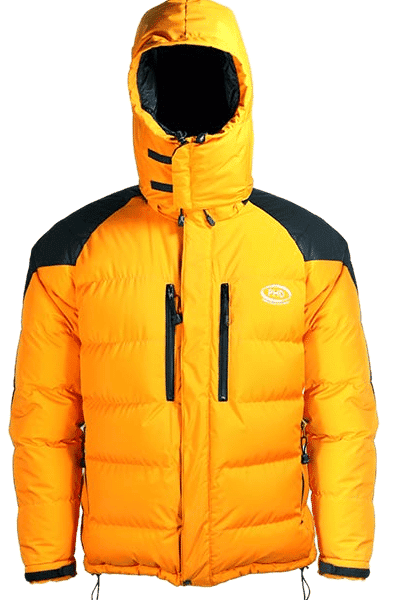
→ 2 trekking shirts (short sleeves)
→ 2 pairs of trekking pants or trousers
→ Fleece or down jacket
→ Fleece pants
→ Sweatshirts
→ Pair of hiking Shorts
→ Rain-proof jacket and pants
→ Winter hat/ peak hat
→ Gloves or mittens (Inner Gloves and out insulated gloves)
→ Beanie
→ Neck Gaiter
→ Disposable underwear
Note: Even in the warmer months of April/May, the weather can be extreme at higher altitudes, so make sure to have a suitably insulated coat (like the one shown), gloves, and headgear. You can rent a down jacket from us.
Headwear
You need to pack certain clothing and headwear for your Everest Base Camp trek. They are as follows:
Sun Hat or Cap
A wide-brimmed sun hat will cover your face, neck, and ears from the direct rays of the sun. During the trek, the sun can be intense, which can lead to dehydration and severe sunburn. Therefore, it is essential to have a wide round cap or at least a sun cap for the trek.
Sunglasses
When the sun is too intense, you will need eye protection. The strong UV rays and intense sun can be harmful to your eyes. Therefore, do not forget to carry sunglasses that provide UV protection. You can also bring extra sunglasses for situations where you may lose or damage them.
Bandana or Scarfs
Bandanas or scarves are useful for protecting your head, mouth, nose, and other areas from the dust on the trails. They also provide warmth.
Beanies or Woolen Cap
Your head needs protection against cold in higher places. And it is freezing in the morning and night hours. So you need something woolen for your head. A woolen cap or beanie will keep your head and ear warm and protected.
Headlamp
Sometimes, you have to trek early in the morning or late in the evening. Unfortunately, the region doesn’t have any lights for such situations, so you have to carry your own light. A headlamp with extra batteries will be enough for the dark times of the trek.
Buff or Neck Gaiter
You need to have something to cover your neck when everything else is covered. A buff or neck gaiter is the perfect clothing accessory for this purpose.
It keeps your neck warm and can also help you protect your mouth. The cold air and weather of the region can easily hit your throat and cause coughing and common cold. But, your neck is safe if you have a warm neck gaiter or buff. Hence, it is essential to gear up for the trek.
Quick list of Headwear for Everest Base Camp
- Sunhat or cap
- Sunglasses(UV)
- Woolen cap or beanie
- Headlamp
- Buff or Neck gaiter
- Scarf or Bandana
Hand-wear
Hands can often be left exposed during many activities, but you can’t leave them bare during the journey to Everest Base Camp. In cold weather, your hands require protection to prevent them from becoming numb and unresponsive.
Therefore, it is essential to have a good pair of gloves. We recommend taking two types of gloves: inner and insulated or outer gloves.
Inner Gloves
The inner gloves are lightweight. They provide moderate warmth and are suitable for use in lower altitude areas, taking care of your hands.
Outer Gloves
Outer gloves have to be waterproof, warm, and durable. It protects your hand when the weather is freezing. The temperature in the high areas is cold, mainly during night hours. Hence, a good pair of insulated outer gloves will keep your hand warm and working.
Footwear
Footwear is one of the noteworthy items on the Everest Base Camp Packing List. Your feet will take you to EBC, so you need some excellent companions for them. To avoid discomfort and blisters, break in your hiking boots months before the trek.
You might also want to bring spare tennis shoes, but the ideal footwear is mid to high-cut hiking boots because they provide ankle support and protect your feet when crossing the river.
Hiking Boots
A sturdy and comfortable pair of hiking boots is a blessing for the trek. Hiking boots will help you complete the walk without hurting your feet. If your hiking boots are not good, you might have a hard and long walk.
You have to walk on all types of terrain during the trek, including forested trails, rough terrains, glacier moraine, and icy paths.
Hence, it is important to get yourself a good pair of hiking boots. The features to look out for are lightness, waterproofing, comfort, and sturdiness.

Hiking Socks
Good hiking socks are breathable and moisture-absorbing. The socks made of merino wool are better at absorbing moisture compared to cotton. Merino wool is also not as smelly after use. Are you thinking about how many socks for everest base camp are needed? Hence, get yourself 3-4 pairs of merino wool-made hiking socks.
Warm Thermal Socks
Good hiking socks are breathable and moisture-absorbing. The socks made of merino wool are better at absorbing moisture compared to cotton. Merino wool is also not as smelly after use. Hence, get yourself 3-4 pairs of merino wool-made hiking socks.
Gaiters
Gaiters prevent things from getting into your boots. You will have a dusty and rough walk on a long trek like the Everest Base Camp Trek. And there will be times when mud and rocks may enter your shoes. Gaiters can help you avoid that. Although not essential, the gear is not a burden in a backpack.
Slippers or Flip Flops
You should allow your feet to breathe when you are off the trail. Slippers or flip-flops are suitable for that purpose. You can use the slippers while wandering inside and around teahouses or lodges.
Quick list of footwear for Everest Base Camp Trek
- Broke-in hiking boots
- Tennis shoes (optional)
- Flip flops (to use in tea houses)
- Thick Socks
Accessories
Trekking Poles
Trekking poles are true saviors during long walks. They simply reduce the impact on your body and make walking easier. However, trekking poles are not compulsory, and the walks are possible without them. It’s up to you to decide whether to use them or not. If you are used to trekking poles, you can carry them.
Sleeping Bag
You will get a bed and blankets in lodges on the trek. However, bringing your own sleeping bag is convenient. Some people may prefer not to use hotel blankets, even if they are clean. Additionally, the weather can get very cold, so a sleeping bag is suggested. A sleeping bag rated to -15 degrees Celsius is recommended for Everest Base Camp.
Water Bottle
Carry reusable water bottles for the Everest Base Camp Trek. You can carry both hot and cold water in these bottles. Find an excellent reusable bottle (32 oz or so) from the market and have it on your back. You can refill your bottle whenever possible and remain hydrated on the trek.
Ziploc Plastic Bags
During the trek, your socks, pants, or other items may become wet. For such instances, you can use ziplock plastic bags to separate wet items from the dry ones.
Bags and Backpacks
Most adventure trekkers have the question in mind about which is the best backpack for the Everest base camp trek. A good, strong, durable, and reliable backpack is essential if your trek lasts for a large number of days.
The type of backpack you need for the Everest Base Camp tour depends on whether you are using a porter or not. If you plan to have a porter, you can use a duffle bag. Whereas, if you are carrying everything, you will need a good backpack.
Have a convenient and easy backpack to carry and handle during your entire trekking day.
Duffel Bag
The Duffel Bag is perfect for trekking. You can use it to keep all your belongings in one place, and the porter will carry it wherever you go. Make sure to choose a lockable, durable, and waterproof duffel bag.
Backpack
A 50-60L hiking backpack can be handy if you carry everything on your back. The backpack is designed for treks like the Everest Base Camp, where you need to have all your things in one place. Therefore, buy a backpack that can accommodate the number of items you plan to carry on the trek.
Day Backpack
Use a daypack to carry your daily essentials, such as sunblock, a camera, snacks, water, and a poncho. However, stash the rest of your belongings in the larger duffel bag that your porter will carry ahead to the next tea house.
A day backpack is recommended only if you plan to have a porter on the trek. While your porter carries your heavy bag, you can take your daily essentials in the daypack. You can also carry chargers, gadgets, chocolates, dry fruits, and other items with you, so you don’t have to call the porter every time.
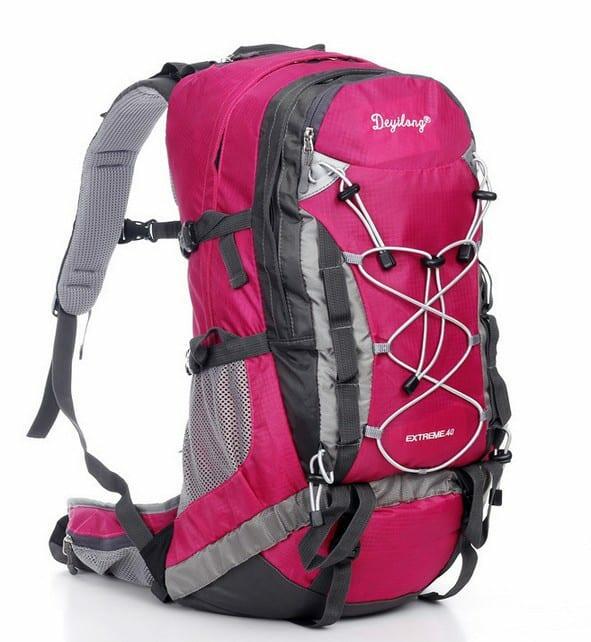
Everest Base Camp Packing List For A Female
If you are a female and planning to go on an Everest Base Camp trek tour, you must pack the below stuff in addition to the list above.
- Leggings
- Long sleeved shirts (three or more)
- Down jackets
- Pair of long johns
- Thermal Breathable Underwear (Undies And Bras)
- Sport bras
- Headbands
- Buff, Balaclava, or Neckband
- Full body, light rain poncho
- Women’s hiking boots
- Trekking sandals and Flip flops for women
- Down shoes
- Wipes (Both baby plus foot wipes)
- SPF sun screen
- Hand sanitizer
- Hiking towel
- Talcum powder
- Face masks
- Books and notebooks
- Small locks
- Tampons
- Soft pillows
- Ear plugs
- Playing cards
- Nail clippers and deodorants
- Plastic bags for garbage
- Plastic bags for dirty clothes
Things to Consider While Choosing a Best Backpack for Everest Base Camp Trek
Well, backpack is needed during your trek time. A backpack is best for your Everest Base Camp Trek if it have a few qualities in it. Here are the few things that you must keep in mind while taking a backpack with you;
- A backpack must be strong and durable for your entire trek trip.
- Do not forget to check the capacity and weight limit your chosen backpack can carry. You can also estimate the capacity from the dimensions of your backpack. Usually 60 to 75 liters capacity for your backpack is enough for your trek plan.
- Your backpack must have the top pocket in which you can keep the items that you might need in an emergency. Top pocket will make it easy and quick to access those items in case of any emergency.
- A best backpack have a haul handle which make it easy to carry and transfer the backpack during your trek.
- Rain cover is good during extreme weather conditions so get a backpack that have this option.
- Shoulder harness of your backpack must suit your torso perfectly according to your torso size.
- Hip belt of your chosen backpack must be adjustable so your can breathe easily. Thick padded layer on the hip belt of your backpack is also necessary to increase comfort.
- Compression strap will not create mess into your backpack and all the things you kept in it will be organized till the day end.
- A good backpack have different compartments and pockets. You can organize things according to the categories or on a need basis. It will make it easier for you to find the stuff you need. Smaller compartments are good for small things whereas large compartments in the backpack are good for big items. Side compartments of your backpack is good to put necessary items like water bottle, tissues, wipes, maps, etc.
Medicine
You may or may not have to deal with altitude sickness, as well as the risks of diarrhea, headaches, and body pain during the trek. Therefore, it’s advisable to bring some medicines with you.
First Aid Kit
Usually, a professional trekking agency with a professional guide carries a first aid kit on treks. However, you can bring your own if you prefer. If you plan to trek independently, a first aid kit is necessary.
- Personal prescriptions
- Ibuprofen
- Medical tape (in case of blisters)
- Diamox (in case of altitude sickness)
- Antibiotics (in case of diarrhea)
Water Purification
You might not feel that tap water in the region is safe to drink, but you can use water purification tablets to drink it safely. These tablets can purify tap water. Therefore, if you want to use tap water but are afraid of it, you should carry water purification tablets.
Water purification tools such as plastic bottles are discouraged because they add litter. Water purification tools are cheaper, portable, and reduce the amount of plastic waste from your travels.
Oximeter
An oximeter is a useful device to have with you on a trek, as it measures your blood oxygen level. You can quickly check your hydration and oxygen level while trekking to avoid altitude sickness.
Lip Balm
Your lips can remain dry on the trek. Pack a lip balm to keep your lips moist and safe against the cold.
Toiletries
Towel
Carry a lightweight and quick-drying towel on the trek. You can use the towel on and off the trail during various trek walks, and you won’t have to use a public towel.
Sunscreen
The sun can be brutal during the trek, but you can use sunscreen to protect your face and skin from the intense rays. This will also help you avoid sunburn. An excellent waterproof sunscreen is enough for the trek.
Wet Wipes
Wet wipes can help clear all the dust off your face and skin. They also work as a sanitizer and keep you hygienic on the trek. Alternatively, you can use wet wipes to refresh yourself.
Hand Sanitizers
You may not have the opportunity to wash your hands every time on the trek, so a hand sanitizer can be your instant disinfectant product. You can avoid germs by using 2-3 drops of hand sanitizer.
Toilet Paper
Toilet paper may not be available for purchase along the trail, so pack it when you are in the main town. It can be used on multiple occasions, and two rolls will be enough for the Everest Base Camp Packing list.
Sanitary Pads or Tampons
Toiletries like sanitary pads may not always be available for purchase along the trek. You can stay relaxed by bringing enough of these items for yourself.
Miscellaneous
Toothbrush, toothpaste, shampoo, soap, and conditioner are essential items that you will definitely have in your backpack. Nail clippers, razors, and other personal grooming essentials are also recommended.
- Soap
- Deodorant
- Toothbrush
- Toothpaste
- Mouthwash
- Sanitary napkins/ tampons/ panty liners
- Hairbrush
- Wet wipes
- Microfiber face towel
- Sunblock spray
- Body lotion/moisturizer
- Lip balm with SPF
Documents
Visa
You need to have a valid visa to enter Nepal. It is available as an arrival visa at Kathmandu Airport, or you can apply for one before coming to Nepal through your nearest Nepalese embassy.
Immunization (against covid-19)
You need to be immunized and have proof of full vaccination against COVID-19 (as of 27th Feb 2023 when updating this post). Only with complete immunization, you will be granted a visa when you arrive at Kathmandu airport.
If you have not been vaccinated against COVID-19, please consult with your nearest Nepalese embassy before planning your trip.
Passport
You must carry your original passport, which should be valid for at least 180 days.
Travel Insurance
Travel insurance is essential when trekking in Nepal. You should be insured against all possible emergencies that may occur on your trek.
Miscellaneous Items
Camera
If you are a shutterbug, you must add a camera to your Everest Base Camp packing list. The trek offers the best sites where you can capture breathtaking pictures. Bring spare batteries, memory cards, and a tripod as required.
You can charge your electronics in tea houses, but expect the charging cost to increase as you go up. Bring a power bank with a large capacity to charge your electronics during the trek.
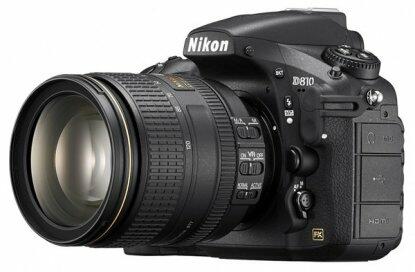
Power Banks
A power bank can store power for emergency usage. It is a handy object to have in your backpack. When there is no power supply, you can charge your devices.
Journal and Pen
If you like to write about things you experience, you should have a journal and a pen. The trek will give you many stories that can influence your writing.
Cards and Books
Cards and books can be good companions when you are off the trail. You can play cards for fun with friends, or you can read your favorite books in your favorite place.
Money
After you leave Kathmandu, there aren’t many ATMs along the EBC trek route. There are ATMs in Namche Bazaar, but you can’t always count on them working. Bring your own cash to purchase souvenirs, snacks, beverages, and other essentials along the way.
Thermal flask
To keep your drinks from freezing in the bottle on the highest days, it is advised that you bring a thermos flask. Bring one if you have a habit of drinking warm water at night, as teahouse staff are sleeping and not there to serve you at night.
Everest Base Camp Trek Cost
Everest base camp trek is the most popular and famous trekking location across globe. It usually take 14 days to complete the trek but entirely depends on the route you choose to trek.
The Everest Base Camp Trek cost vary and depends on the kind of trip you choose. You might prefer private trekking experience or may join a group. Mode of payment (individual or group) also impact the cost of Everest base camp trek.
If you join a group, the cost is around $1445 per person for 2024. If you need additional services, cost may increase then the given estimate. Below is the table in which the cost is given according to the number of persons in a trek plan.
A rough estimate of the cost from USD 1500 to USD 5000 must kept in the mind. The price may vary according to the services, trekking days, and the travel agency you choose for your trek plan.
At Last
The above is the complete Everest Base Camp packing list. Some of the items are optional, whereas most of them are essential. We hope you now know how to backpack for Everest Base Camp. Pack all the important things and have a wonderful experience.
We might be one if you are looking for a well-managed and experienced trekking agency. Our professional team will ensure you have a good time in the Everest Region.
Kindly let us know, through comment below, if we missed anything!
Want more information? Send us your query, and our experts will get back to you within 24 hrs.
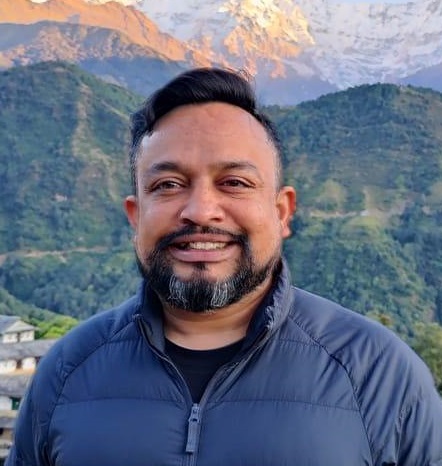
Raj is the co-founder of Mosaic Adventure who have immense knowledge of all the trail throughout Nepal. Working on the trekking industry for more than three decades Raj knows the country like back of his hands. If you need more information or help to plan any trips to Nepal, feel free to get in touch with Raj through his email [email protected] or whatsapp him on +9779851090836.


